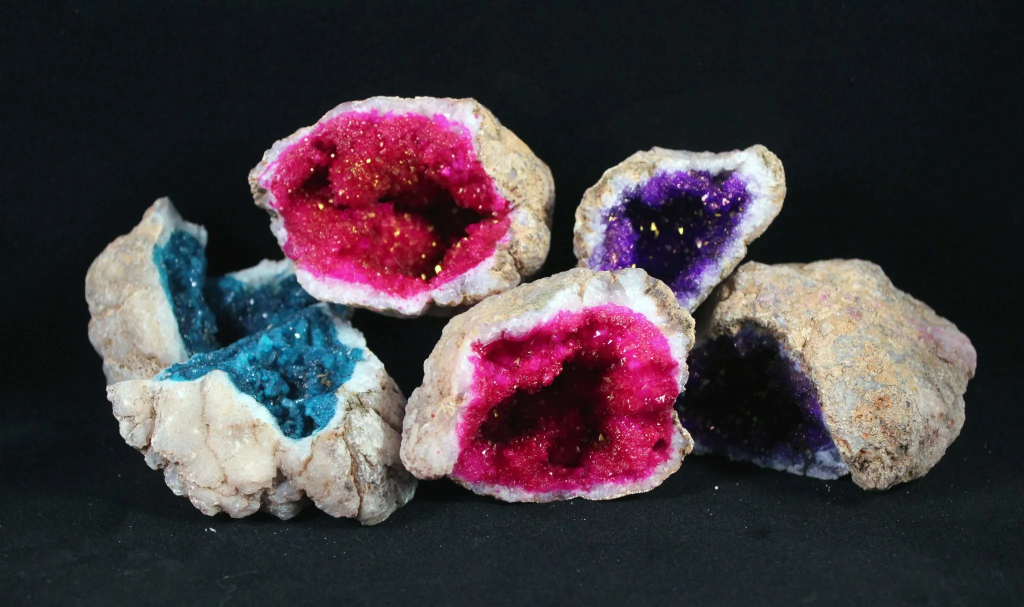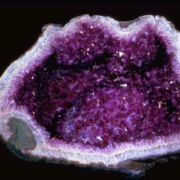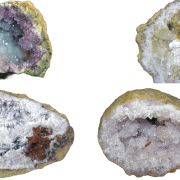Discovering the World of Geodes: Types, Formations, and Uses
Introduce World of Geodes
Geodes are extraordinary natural wonders, captivating those who discover their hidden beauty. These unassuming spherical rocks, often plain on the outside, reveal a dazzling array of crystals and minerals when cracked open. Found in various regions across the globe, geodes vary widely in type, formation, and mineral content. In this comprehensive exploration, we’ll uncover the different World of Geodes, how they form, where they can be found, and the minerals that contribute to their unique charm.

What Are Geodes?
Before we explore the various types of geodes, it’s essential to understand what geodes are and how they are formed. Geodes begin as hollow spaces within rocks, which can originate in multiple ways, such as gas bubbles in volcanic rock or cavities in sedimentary formations. Over millions of years, mineral-rich water infiltrates these voids. As the water slowly evaporates, it leaves behind deposits of crystals and minerals, forming intricate and beautiful structures within the geode.
Exploring Different Types of Geodes
Geodes are categorized by the types of crystals and minerals they contain and their geographical locations. Below are some of the most well-known types:
Amethyst Geodes
Amethyst geodes are prized for their striking purple crystals, making them some of the most popular geodes among collectors. These geodes form within volcanic rock, where silica-rich solutions percolate into cavities, depositing layers of amethyst crystals. The deep purple hues and elegant formations of these geodes are primarily sourced from Brazil and Uruguay, but they can also be found in other parts of the world.
- Characteristics: Amethyst geodes range from pale lavender to rich, deep purple. Their crystals are typically pointed and hexagonal.
- Common Uses: Amethyst geodes are used in jewelry, home decor, and spiritual practices, particularly for promoting tranquility and balance.
- Formation Process: Amethyst geodes form in volcanic rocks, with the crystals growing as mineral-rich water seeps into cavities and evaporates over time.
- Locations: Major deposits are found in Brazil, Uruguay, and other locations such as Mexico, the United States, and Canada.
- Mineral Content: The distinctive purple color of amethyst is due to the presence of iron impurities within the quartz during crystal formation.
Quartz Geodes
Quartz geodes are among the most widespread, known for their clear or milky-white crystals that shimmer when exposed to light. These geodes are highly valued for their versatility and are commonly found in many parts of the world, including the United States, Mexico, Brazil, and Namibia.
- Characteristics: Quartz geodes typically feature clear, white, or smoky crystals, which may be small and clustered or large and well-defined.
- Common Uses: They are often used in jewelry, home decoration, and metaphysical practices, where they are believed to amplify energy.
- Formation Process: Quartz geodes usually form in sedimentary rocks such as limestone, where silica deposits crystallize over time.
- Locations: Prominent sources include the United States, Mexico, Brazil, and Namibia.
- Mineral Content: Quartz geodes are primarily composed of silica, with occasional inclusions of other minerals like calcite or chalcedony.
Agate Geodes
Agate geodes are renowned for their vibrant colors and distinctive banding patterns, which result from the layered deposition of chalcedony and quartz within volcanic rocks. These geodes are highly sought after for their unique and intricate designs.
- Characteristics: Agate geodes display a wide spectrum of colors, including blue, red, green, and yellow, with banded patterns often surrounding quartz crystals.
- Common Uses: Agate geodes are popular in jewelry, decorative items, and metaphysical practices, particularly for grounding and stability.
- Formation Process: These geodes form in volcanic rocks, where silica-rich water deposits layers of chalcedony and quartz in cavities.
- Locations: Agate geodes are primarily found in Brazil, Mexico, and parts of the United States, such as Oregon and Arizona.
- Mineral Content: The banding in agate geodes is primarily composed of chalcedony, a microcrystalline form of quartz, with additional quartz crystals often present.
Celestite Geodes
Celestite geodes are cherished for their soft blue crystals, which evoke a sense of calm and serenity. These geodes are typically found in sedimentary rocks, where strontium sulfate crystallizes within cavities.
- Characteristics: Celestite geodes feature delicate, sky-blue crystals that are often prismatic and fragile.
- Common Uses: These geodes are valued for their aesthetic appeal and metaphysical properties, particularly in enhancing communication and clarity.
- Formation Process: Celestite geodes form in sedimentary environments, where groundwater deposits strontium sulfate crystals in cavities.
- Locations: The most notable celestite geodes come from Madagascar, with other sources in the United States (Ohio) and Mexico.
- Mineral Content: Celestite crystals are composed of strontium sulfate, which imparts their characteristic blue color.
Calcite Geodes
Calcite geodes are known for their vibrant colors and diverse crystal formations, often showcasing hues of white, yellow, orange, red, and green. These geodes form in sedimentary rock environments where calcium carbonate crystallizes over time.
- Characteristics: Calcite geodes display a range of colors and crystal shapes, including rhombohedrons and scalenohedrons.
- Common Uses: They are popular for decorative items, educational specimens, and metaphysical practices, particularly for healing.
- Formation Process: Calcite geodes form in sedimentary rocks as calcium carbonate crystallizes from groundwater.
- Locations: They are primarily found in the United States, Mexico, and Romania.
- Mineral Content: Calcite geodes are composed mainly of calcium carbonate, with occasional inclusions of minerals like pyrite or quartz.
Septarian Geodes
Septarian geodes, often referred to as “dragon stones,” are unique for their striking patterns and a mixture of minerals. These geodes form in sedimentary environments, often around organic material, and are known for their distinctive appearance.
- Characteristics: Septarian geodes feature a mix of yellow calcite, brown aragonite, and gray limestone, often creating dramatic contrasts.
- Common Uses: These geodes are used in decorative items, jewelry, and metaphysical practices for grounding and protection.
- Formation Process: Septarian geodes form through the concretion of minerals in sedimentary environments, typically around organic material.
- Locations: Major sources of septarian geodes include Utah (United States) and Madagascar.
- Mineral Content: The yellow crystals are composed of calcite, the brown patterns of aragonite, and the matrix is typically limestone.
The Formation Journey of Geodes
The creation of a geode is a slow and fascinating process that spans millions of years. Here’s an outline of how geodes form:
- Cavity Formation: Geodes originate as hollow spaces within rocks. These cavities can form from volcanic activity, where gas bubbles create voids, or within sedimentary rocks through the dissolution of nodules.
- Mineral-Rich Water Infiltration: Over time, mineral-laden water seeps into the cavity. This water carries dissolved minerals like silica, calcite, or strontium.
- Crystal Growth: As the water gradually evaporates, the dissolved minerals begin to crystallize on the cavity walls, creating layers of crystals.
- Final Formation: After millions of years, the cavity becomes fully lined or filled with crystals, forming the geode. The exterior remains rough, while the interior displays a stunning array of crystals.
Collecting and Utilizing Geodes
Geodes are treasures for collectors, jewelry makers, and those who appreciate natural beauty. Here’s how you can collect and use geodes:
Collecting Geodes
- Field Exploration: Certain regions are well-known for geode hunting. Always check local regulations before venturing out.
- Buying: Geodes are widely available for purchase at rock shops, gem shows, and online. Ensure that you buy from reputable sources.
- Cracking Events: Some events allow you to choose a geode and have it professionally cracked on-site, revealing its hidden beauty.
- Guided Tours: Consider joining guided tours organized by geological societies for expert guidance and access to prime geode-hunting locations.
- Joining Clubs: Local gem and mineral clubs often organize field trips and offer a community of enthusiasts to share knowledge and tips.
- Educational Workshops: Participate in workshops offered by museums or universities to learn more about geode formation, identification, and preservation.
Using Geodes
- Home Decoration: Geodes are stunning additions to home decor, adding a touch of natural elegance to any space.
- Jewelry: Small geodes and slices are popular in jewelry making, creating unique and eye-catching pieces.
- Metaphysical Practices: Geodes are widely used for their believed energy-amplifying properties, making them popular in spiritual practices.
- Education: Geodes serve as excellent educational tools, helping to teach about mineral formation and geology.
- Gift Giving: Their natural beauty makes geodes thoughtful gifts for rock enthusiasts and those interested in the metaphysical.
- Aquariums and Terrariums: Geodes can enhance the aesthetic of aquariums and terrariums, adding a naturalistic element to these environments.
- Art and Crafts: Geodes can be incorporated into various art projects, such as resin art or mosaics, for a unique and natural touch.
Cleansing and Charging Geodes
To maintain their beauty and energy, it’s important to regularly cleanse and charge your geodes:
Cleansing
- Running Water: Gently rinse your geode under cool running water to remove negative energy. Be cautious with delicate crystals.
- Smudging: Pass your geode through the smoke of sage or incense to cleanse it of any unwanted energy.
- Moonlight: Place your geode in the moonlight overnight to cleanse and recharge its energy.
Charging
- Sunlight: Expose your geode to sunlight for a few hours. However, be mindful of prolonged exposure, as it can fade the colors of certain crystals.
- Earth Burial: Bury your geode in the earth for 24 hours to deeply cleanse and recharge it.
- Crystal Clusters: Place your geode on a larger crystal cluster like quartz or selenite to recharge its energy.
Conclusion
Geodes are mesmerizing creations that showcase the earth’s natural beauty. From the rich purples of amethyst to the soothing blues of celestite, each type of geode offers its own unique appeal. Whether you’re a collector, a jewelry maker, or simply someone who appreciates the wonders of nature, geodes provide endless fascination and enjoyment. By understanding their formation, properties, and uses, you can deepen your appreciation for these incredible geological treasures.
“Explore the hidden wonders of geodes—unlock the secrets of their formation, beauty, and uses. Click here to discover our collection of stunning geodes for every collector.”
A geode is a hollow, spherical rock with an interior lined with crystals and minerals. Geodes form when mineral-rich water infiltrates cavities within rocks, such as gas bubbles in volcanic rocks or voids in sedimentary formations. Over millions of years, the water evaporates, leaving behind deposits of crystals and minerals that grow within the cavity, creating the geode’s unique structure.
Some of the most common types of geodes include:
- Amethyst Geodes: Known for their deep purple crystals, primarily found in Brazil and Uruguay.
- Quartz Geodes: Featuring clear or milky-white crystals, commonly found in the United States, Mexico, Brazil, and Namibia.
- Agate Geodes: Renowned for their colorful banded patterns, often found in Brazil, Mexico, and the United States.
- Celestite Geodes: Recognized for their soft blue crystals, with significant sources in Madagascar and the United States.
The type of crystals inside a geode can often be identified by their color, shape, and structure. For example:
- Amethyst: Purple, hexagonal crystals.
- Quartz: Clear or white, often hexagonal crystals.
- Agate: Banded patterns with various colors.
- Celestite: Sky-blue, prismatic crystals. If you’re unsure, you can take the geode to a gemologist or a geology expert for accurate identification.
To cleanse and charge your geodes:
- Cleansing: Rinse the geode under cool running water, pass it through the smoke of sage or incense, or leave it in moonlight overnight.
- Charging: Place the geode in sunlight for a few hours (be cautious with colored geodes to avoid fading), bury it in the earth for 24 hours, or place it on a larger crystal cluster like quartz or selenite to recharge its energy.
You can collect geodes in regions known for geode deposits, such as parts of the United States (Iowa, Missouri, Utah), Brazil, and Mexico. Be sure to check local regulations before collecting. If purchasing, geodes are available at rock shops, gem shows, and online. To ensure authenticity, buy from reputable sellers and consider asking for a certificate of authenticity, especially for rare or valuable specimens.


Leave a Reply
Want to join the discussion?Feel free to contribute!